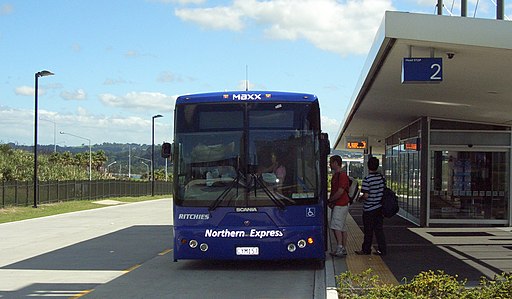This encouraging Reinventing Transport episode takes another look at Auckland in New Zealand.
This time we focus on the city itself and how this car-dependent metropolitan area has been showing its peers how to change course.
This is actually the third part of my December 2018 discussion with Matt Lowrie and Patrick Reynolds, two of the bloggers on the Greater Auckland blog. In the first part, which was Reinventing Transport episode #9, we looked at their blog, Greater Auckland, and how it has become so influential. The second part was on my other podcast, Reinventing Parking, recently, where Matt and I talked about Auckland’s impressive parking reforms.
Auckland’s experience has a lot to teach other cities and Patrick and Matt are incredibly knowledgeable guides.
- Auckland is still a car-dependent city but it is now rapidly becoming less car-dependent. All the key trends are in the right direction. [1:20]
- Rapid population growth and a geography full of bottlenecks forced a re-evaluation of mobility scenarios as a roads-based strategy approached some practical limits. [2:27]
- The 2010 amalgamation of multiple local governments into a unified Auckland Council was a game changer too. [4:00]
- Auckland has been lucky to avoid party politics at the local level and has so far not seen transport and urban planning issues embroiled too much in urban-versus-suburban culture wars politics. [4:51]
- A little history lesson: a tram-based city of half a million people embraced automobile-based transport planning for many decades starting in the 1950s; but from early in the 2000s an urban renaissance has been gathering momentum, with growing confidence that a quality city-centre and better public transport (among other things) are possible. Key events included hosting the America's Cup in 1999-2000, the shift of the hub of suburban rail back to the northern end of the city centre in 2003 (Britomart) and the Northern Busway in 2008 [6:06]
- We discussed the Northern Busway and why it was significant. [10:47]
 |
| Auckland's Northern Busway |
- Auckland (and New Zealand generally) is a great case study on the wonky subject of bus regulation. A radical deregulation in the 1990s led to significant problems. In 2008, a government-planned system with gross-cost contracting was established and survived (more-or-less) a review the following year, after a change of government. [15:40]
- Auckland has also been revamping its bus network and has been rolling out, region by region, the New Network. Jarrett Walker was involved and the New Network is a "connective network" with a simpler but less CBD-focused set of lines, more lines with short headways, and more connections (transfers). These network changes became possible after bus regulatory reform [19:21]
- The Congestion Free Network, devised and championed by the Greater Auckland blog, played an important role in Auckland's public transport debates. Its strengths were, a) mode-agnostic network thinking, not project-focused thinking, and b) the 'congestion-free' framing. [21:55]
- Auckland's controversy over mass transit to its airport is a great example of the power of mode-agnostic network thinking in public transport planning. [25:17]
- Land-use planning used to be thoroughly car-dependent but the 30-year vision and the Unitary Plan that emerged from the council amalgamation have decisively shifted towards more transit-oriented planning and intensification, especially in the core and along mass transit lines. (This included parking reform - as discussed in my Reinventing Parking episode on Auckland.) There are said to be more cranes on the Auckland skyline now than in any North American city. [27:34]
- I asked about several recent changes that we might expect to trigger cries of "war on cars" and how did these come about. (Unfortunately, we lost some audio from Patrick in which he explained the city-centre revitalisation proposals.) Matt explained how the Council and the national Government came together to agree on a long-term mass transit plan, with Auckland Council funding via a regional fuel tax. Over the last 10 years or so, there has been no growth in traffic into the central area but major growth in arrivals by other modes. [31:38]
- We ended with a summary of many of the good things that have been happening incrementally with continuous improvements in Auckland over the last 10 years or so: integrated ticketing, integrated fares, an improved bus network, changed the contracting of buses, electrified the trains, bought more trains, added busways and bus lanes, added bicycle tracks, improved walking conditions, and seen strong growth of apartment building in the core and along transit lines, and so on. [34:46]
The struggle goes on of course, as you will see if you visit the Greater Auckland blog. But I found Auckland's story incredibly encouraging.
I live in Singapore but I am from Adelaide in Australia and I really hope Australian cities start looking to Auckland for ideas and inspiration.
For more information on Auckland and its ongoing transformations:
- explore the Greater Auckland blog
- check out Auckland's Unitary Plan
- explore the Auckland Transport website
IF YOU LIKED THIS EPISODE
Please do recommend Reinventing Transport to any of your friends or colleagues who might be interested. Please share on social media too!Subscribe, if you haven't already (it's free):
- sign up to get updates by email from this site
OR - subscribe to the audio podcast (search for 'Reinventing Transport' in your podcast player app or click the symbol that looks like a wifi icon in one of the players at the top or bottom of this article).


thank you.
ReplyDelete